D.W. Wilkin's Blog, page 146
March 18, 2015
Regency Personalities Series-Esther Abrahams
Regency Personalities Series
In my attempts to provide us with the details of the Regency, today I continue with one of the��many period notables.
Esther Abrahams
1767 ��� 26 August 1846
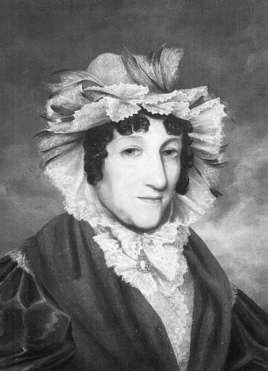
Esther Abrahams
Esther Abrahams was put on trial at the Old Bailey, in London, on 30 August 1786 for stealing lace with a value of 50 shillings. She was found guilty of theft, although the evidence was circumstantial. At the time of the trial she was about 18 years old; her occupation was listed as ‘milliner’. She was imprisoned in Newgate Gaol, London, where she bore an illegitimate child named Roseanna, father unknown, on 18 March 1787.
Abrahams and her daughter were transported to Australia with the First Fleet, departing London in May 1787 on the convict transport Prince of Wales but transferring to Lady Penrhyn mid-voyage. They reached Sydney with the Fleet in January 1788.
From 1800, Esther Abrahams began calling herself Julian, originally Juliano, after a renowned Judeo-Spanish family.
Esther entered into a relationship with George Johnston, First Lieutenant of the Marines, who had accompanied the First Fleet. She bore him seven children, including their two sons David and Robert. Their house was probably a wattle and daub cottage built by convicts. On 26 January 1808, Johnston led the Rum Rebellion, which overthrew Governor Bligh.
Because of his rank, Johnston received huge land grants. He was born in Annandale, Scotland, and named their farm after that place as was the custom. It is now a suburb of Sydney. George’s River was named after him. Esther received land grants in her own right in 1809. Despite having led the rebellion, Johnston was able to keep his land when he returned to Australia after an absence of four years. Esther had been left in charge of the estate in his absence. When Johnston finally married Esther in November 1814, Roseanna and her husband acted as witnesses at the wedding.
In 1823, Johnston died. Shortly there after, disputes arose over the inheritance of the properties. Her son David had been left property of his own. However, Robert was to inherit Annandale on Esther’s death. Much to her distress, he issued a writ against her in March 1829, on the grounds that his mother should be declared insane and therefore incapable of running Annandale properly. Esther put up a strong legal battle, producing many witnesses to prove she was of sound mind. Her refutation of the insanity claim was upheld; but trustees were nonetheless appointed to manage her affairs. Following the case, Esther went to live with David.
Esther died in 1846, and was buried beside her husband in the family vault on the Annandale property. She was described by her grandson as “always a stirring industrious woman”. Her portrait hangs in the Sydney Jewish Museum.
While her husband is remembered in various geographic names, there was, until 2002, no such feature in Sydney named in Esther’s memory. In 2002 a pavilion was dedicated in Bicentennial Park, in Johnston Street, Annandale, New South Wales, near the Anzac Bridge.
Her Illegitimate daughter Roseanna (whose name is sometimes given in sources as Rosannah) grew up to marry emancipated convict Isaac Nichols, who was appointed as (the first Postmaster of the colony), in 1805.

A Jane Austen Sequel: Colonel Fitzwilliam’s Correspondence
Colonel Fitzwilliam���s Correspondence For your enjoyment, one of the Regency Romances I published.
It is available for sale and I hope that you will take the opportunity to order your copy.
For yourself or as a gift. It is now available in a variety of formats.
For just a few dollars this Regency Romance can be yours for your eReaders or physically in Trade Paperback.
Visit the dedicated Website
Barnes and Noble for your Nook or in Paperback
Amazon for your Kindle or in Trade Paperback
Witnessing his cousin marry for love and not money, as he felt destined to do, Colonel Fitzwilliam refused to himself to be jealous. He did not expect his acquaintance with the Bennet Clan to change that. ������
Catherine Bennet, often called Kitty, had not given a great deal of thought to how her life might change with her sisters Elizabeth and Jane becoming wed to rich and connected men. Certainly meeting Darcy���s handsome cousin, a Colonel, did not affect her. ����
��But one had to admit that the connections of the Bingleys and Darcys were quite advantageous. All sorts of men desired introductions now that she had such wealthy new brothers. ������
Kitty knew that Lydia may have thought herself fortunate when she had married Wickham, the first Bennet daughter to wed. Kitty, though, knew that true fortune had come to her. She just wasn���t sure how best to apply herself.
Feedback
If you have any commentary, thoughts, ideas about the book (especially if you buy it, read it and like it ;-) then we would love to hear from you.

March 17, 2015
Regency Personalities Series-Henry Paget 1st Earl of Uxbridge
Regency Personalities Series
In my attempts to provide us with the details of the Regency, today I continue with one of the��many period notables.
Henry Paget 1st Earl of Uxbridge
18 June 1744 ��� 13 March 1812
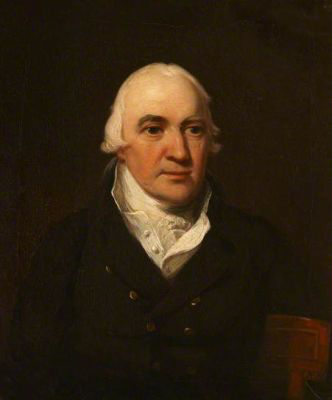
Henry Paget
Henry Paget 1st Earl of Uxbridge was born Henry Bayly, Uxbridge was the eldest son of Sir Nicholas Bayly, 2nd Baronet, of Plas Newydd in Anglesey, by his wife Caroline Paget, daughter of Brigadier-General Thomas Paget and a great-granddaughter of William Paget, 5th Baron Paget. He succeeded as 10th Baron Paget in 1769 on the death of his mother’s second cousin the Earl of Uxbridge and by Royal Licence on 29 January 1770, took the name of Paget in lieu of Bayly. In 1782 he succeeded his father as 3rd Baronet.
Uxbridge became Lord Lieutenant of Anglesey in 1782. On 19 May 1784 he was created Earl of Uxbridge, in the County of Middlesex. He was also Lord Lieutenant of Staffordshire between 1801 and 1812, Constable of Caernarfon Castle, Ranger of the Forest of Snowdon, Steward of Bardney, and Vice-Admiral of North Wales.
Lord Uxbridge married Jane, daughter of the Very Reverend Arthur Champagn��, Dean of Clonmacnoise, a descendant of a well-known Huguenot family which had settled in Ireland, in 1767. They had twelve children:
Field Marshal Henry William Paget, 1st Marquess of Anglesey (17 May 1768 ��� 29 April 1854)
Captain Hon. William Paget (c. 1770���1795)
Hon. Sir Arthur Paget(15 January 1771 ��� 26 July 1840)
Lady Caroline Paget (1773-9 July 1847)
General Hon. Sir Edward Paget (3 November 1775 ��� 13 May 1849)
Lady Jane Paget (c. 1777-30 June 1842), married George Stewart, 8th Earl of Galloway.
Vice-Admiral Hon. Sir Charles Paget (7 October 1778 ��� 27 January 1839)
Hon. Berkeley Thomas Paget (1780���1826)
Lady Louisa Paget (c. 1781-23 January 1842)
Lady Mary Paget (c. 1783-29 April 1835)
Lady Charlotte Paget (c. 1785-26 January 1817)
Hon. Brownlow Paget (c. 1797-1797)
Lord Uxbridge died in March 1812, aged sixty-seven, and was succeeded in the earldom by his eldest son Henry. The Countess of Uxbridge died in March 1817, aged seventy-five.

An Unofficial Guide to how to win the Scenarios of Rollercoaster Tycoon 3 Soaked and Wild
An Unofficial Guide to how to win the Scenarios of Rollercoaster Tycoon 3, Soaked! and WILD!
I have been a fan of this series of computer games since early in its release of the very first game. That game was done by one programmer, Chris Sawyer, and it was the first I recall of an internet hit. Websites were put up in dedication to this game where people showed off their creations, based on real amusement parks. These sites were funded by individuals, an expense that was not necessarily as cheap then as it is now. Nor as easy to program then as it might be to build a web page now.
Prima Books released game guides for each iteration of the game, Rollercoaster Tycoon 1, Rollercoaster Tycoon 2 and Rollercoaster Tycoon 3 (RCT3) but not for the expansion sets. And unlike the first two works, the third guide was riddled with incorrect solutions. As I played the game that frustrated me. And I took to the forums that Atari, the game publisher hosted to see if I could find a way to solve those scenarios that the Prima Guide had written up in error. Not finding any good advice, I created my own for the scenarios that the ���Official��� Guide had gotten wrong.
Solutions that if you followed my advice you would win the scenario and move on. But if you followed the
���Official��� version you would fail and not be able to complete the game. My style and format being different than the folks at Prima, I continued for all the Scenarios that they had gotten right as well, though my solutions cut to the chase and got you to the winner���s circle more quickly, more directly.
My contributions to the ���Official��� Forum, got me a place as a playtester for both expansions to the game, Soaked and Wild. And for each of these games, I wrote the guides during the play testing phase so all the play testers could solve the scenarios, and then once again after the official release to make changes in the formula in case our aiding to perfect the game had changed matters. For this, Atari and Frontier (the actual programmers of the game) placed me within the game itself.
And for the longest time, these have been free at the ���Official��� Forums, as well as my own website dedicated to the game. But a short time ago, I noticed that Atari, after one of its bankruptcies had deleted their forums. So now I am releasing the Guide for one and all. I have added new material and it is over 150 pages, for all three games. It is available for the Kindle at present for $7.99. It is also available as a trade paperback for just a little bit more.
You can also find this at Smashwords, iBooks, Kobo and Barnes and Noble
(Click on the picture to purchase)
Not only are all 18 Scenarios covered, but there are sections covering every Cheat Code, Custom Scenery, the famous Small Park Competition, the Advanced Fireworks Editor, the Flying Camera Route Editor which are all the techniques every amusement park designer needs to make a fantastic park in Rollercoaster Tycoon 3.
Scenarios for RCT 3
1) Vanilla Hills
2) Goldrush
3) Checkered Flag
4) Box Office
5) Fright Night
6) Go With The Flow
7) Broom Lake
8) Valley of Kings
9) Gunslinger
10) Ghost Town
11) National Treasure
12) New Blood
13) Island Hopping
14) Cosmic Crags
15) La La Land
16) Mountain Rescue
17) The Money Pit
18) Paradise Island
Scenarios for Soaked!
1) Captain Blackheart’s Cove
2) Oasis of Fun
3) Lost Atlantis
4) Monster Lake
5) Fountain of Youth
6) World of the Sea
7) Treasure Island
8) Mountain Spring
9) Castaway Getaway
Scenarios for WILD!
1) Scrub Gardens
2) Ostrich Farms Plains
3) Egyptian Sand Dance
4) A Rollercoaster Odyssey
5) Zoo Rescue
6) Mine Mountain
7) Insect World
8) Rocky Coasters
9) Lost Land of the Dinosaurs
10) Tiger Forest
11) Raiders of the Lost Coaster
12) Saxon Farms

March 16, 2015
Regency Personalities Series-Colin Robertson
Regency Personalities Series
In my attempts to provide us with the details of the Regency, today I continue with one of the��many period notables.
Colin Robertson
July 27, 1783 ��� February 4, 1842
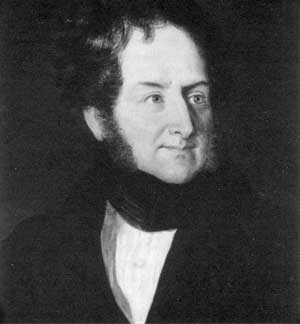
Colin Robertson
Colin Robertson was an early Canadian fur trader and political figure.
He was born in Perth, Scotland in 1783. He originally apprenticed in Scotland as a hand weaver but later travelled to New York City where he found work in a grocery store. By 1803, he had joined the North West Company, leaving it in 1809. Robertson then travelled to England, where he became a merchant at Liverpool. In 1814, he returned to Canada in the employ of the Hudson’s Bay Company, leading an expedition reestablish the company in the area around Lake Athabasca. Robertson stopped in Manitoba to rebuild Fort Douglas, which had been burnt down by the North West Company. In the meantime, John Clarke continued on to the Athabaska region with the remainder of the expedition but was eventually taken prisoner by the North West Company.
Unable to come to an agreement with Robert Semple, the new governor of Assiniboia, Robertson travelled to York Factory, Manitoba, intending to return to England. After stopping in Montreal to clear his name of charges brought forward by the North West Company, he led a new expedition west. He was taken prisoner by Samuel Black of the North West Company but escaped, fled to the United States and returned to England. In the meantime, Lord Selkirk, who had been guaranteeing Robertson’s business debts, had died and Robertson was forced to flee to France. He later returned to Lower Canada.
In 1821, the Hudson’s Bay Company and North West Company were united and Robertson became a chief factor in the new company. Now that the two companies were no longer competing, however, men of action were valued less by the company than persons with administrative skills. After falling out of favour with the company’s governor, George Simpson, he planned to retire but suffered a paralyzing stroke in 1832. He eventually retired in 1840 and was elected to the Legislative Assembly of the Province of Canada for Deux-Montagnes in the following year.
Robertson died in Montreal in 1842 after an accident where he was thrown from his sleigh.
Some people believe that Mount Robson was named after Colin Robertson.

Space Opera Books presents ECO Agents:Save The Planet a Young Adult Adventure
First ECO Agents book available
Those who follow me for a long time know that I also write in other fields aside from Regency Romance and the historical novels I do.
A few months ago, before the end of last year and after 2011 NaNoWriMo, (where I wrote the first draft of another Regency) I started work on a project with my younger brother Douglas (All three of my brothers are younger brothers.)
The premise, as he is now an educator but once was a full on scientist at the NHI and FBI (Very cloak and dagger chemistry.) was that with the world having become green, and more green aware every week, why not have a group of prodigies, studying at a higher learning educational facility tackle the ills that have now begun to beset the world.
So it is now released. We are trickling it out to the major online channels and through Amazon it will be available in trade paperback. Available at Amazon for your Kindle, or your Kindle apps and other online bookstores. For $5.99 you can get this collaboration between the brothers Wilkin. Or get it for every teenager you know who has access to a Kindle or other eReader.
Barnes and Noble for your Nook Smashwords iBookstore for your Apple iDevices Amazon for your Kindle
Five young people are all that stands between a better world and corporate destruction. Parker, Priya, JCubed, Guillermo and Jennifer are not just your average high school students. They are ECOAgents, trusted the world over with protecting the planet.
Our Earth is in trouble. Humanity has damaged our home. Billionaire scientist turned educator, Dr. Daniel Phillips-Lee, is using his vast resources to reverse this situation. Zedadiah Carter, leader of the Earth���s most powerful company, is only getting richer, harvesting resources, with the aid of not so trustworthy employees.
When the company threatens part of the world���s water supply, covering up their involvement is business as usual. The Ecological Conservation Organization���s Academy of Higher Learning and Scientific Achievement, or simply the ECO Academy, high in the hills of Malibu, California overlooking the Pacific Ocean, is the envy of educational institutions worldwide.
The teenage students of the ECO Academy, among the best and brightest the planet has to offer, have decided they cannot just watch the world self-destruct. They will meet this challenge head on as they begin to heal the planet.
Feedback
If you have any commentary, thoughts, ideas about the book (especially if you buy it, read it and like it ;-) then we would love to hear from you.

March 15, 2015
Friday Interviews- Giselle Marks
Today we are fortunate to have with us Giselle Marks who writes Regency & Georgian Romance, Sci-fi/ Fantasy and poetry. However now we want to hear of her historical work in the Regency Romance field.
1) What moved you to become an author? I always knew that I could write, but my first published writing efforts were all non-fiction. I worked part time for a tiny now defunct local newspaper and I sold mostly agricultural articles to both the local and national press. I was member of a small writing club and wrote some short stories for the group. However I did not write a full length novel until I discussed some feminist scifi with a friend and although I had enjoyed the writing I disagreed that a future under female rule would turn out so pleasantly. I suggested that if women were dominantly in charge and were not physically weaker than men that our rulers would have all the faults and strengths of male rulers. I started writing the Zeninan Saga which I am now finally talking to publishers about getting out for the world to read.
I have always read across genre and although a fan of sci fi and fantasy I was very much a Georgette Heyer fan and love to read Regency romances in my spare time. At some point I decided to try my hand at writing a Regency Romance. I looked at the titles on my shelf and noticed all the wives, brides and daughters of noblemen, generals, pirates and other Regency occupations. I thought through what occupations had not been used. I chose Fencing Master and so I wrote my delicately beautiful but ���kickass��� heroine Madeline in the Fencing Master���s Daughter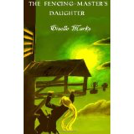
��
2) How did you find out about the Chocolate House project [image error]? I was honored to be asked by Francine Howarth (DWW-our fearless leader for this project who is a very well respected Regency and historical writer if I would be prepared to write a novella for a Charity anthology. I was pleased to be invited.
3) Can you tell us some of the things that attracted you to writing this? I wanted to write the story because Francine asked and it was for Charity. However actually writing it did not so much attract me as present me with a challenge. I knew from writing short stories that writing to a specific short length is very much harder than just writing a novel and then trimming it to approximate length. I had never written a novella in any genre before, I have one short fantasy story that is just under 8K but I had intended that to be much shorter. I worried that to get a beginning, middle and end of a Regency Romance into 14K might prove very demanding.
4) Tell us about your current story in the anthology. ���A Rose by Any Other Name��� is a fairly traditional Regency romance for me to write. I decided to keep to simplicity in order to produce a compact complete story in the space allowed. So I have an older hero who has chosen to remain a bachelor, concerned that his heir is about to make an unfortunate marriage to an actress. Giles Perdue, Earl of Chisolm resolves to visit Bath to buy her off. He misunderstands the situation and falls for the beautiful Rosalie King. She is however, an heiress in disguise, escaping from a forced marriage to her cousin but time is running out. Her cousin must make sure she marries him or that she dies because their family will lose control of her fortune.
5) How did the story begin to develop in your mind? First I needed a reason for Giles to visit Bath where the stories in the anthology are set. I decided a worrying letter from his nephew and heir David would get him there fast. I thought it amusing that while believing himself to be saving his heir from a misalliance that he would fall himself for the lady. Once I had that scene the rest fell in place quite quickly. I decided on Rosalie for a first name alias for my heroine because there are so many variations that can be shortened to Rose. After that the quote from ���Romeo and Juliet��� seemed an obvious title.
6) What did you find most challenging about this story? Keeping to the length required, I did have to go back and trim the length a little. However I found it hard not making Giles too arrogant and unromantic in his dealing with Rose and David Wilkins was right in rebuking me for making Rose a little too sassy and unladylike in the first draft.
7) Tell us a little about yourself? I live in the Isle of Man and I love writing. When my children grew up I decided to see if I could get some of my stories published, partly because I was not finding the stories I wanted to red among those that had been published. I write whatever my characters tell me to write and the genres I work in may increase in the future. I think it is important to try and get the history correct when writing historical romance.
8) What is your next work, and beyond that, what do you want to work on. My next work published will probably be ���Fae Tales��� which is an anthology of contemporary fairy and mythic tales written by myself and Sarah Waldock (DWW-I have been working with the very talented Sarah as an illustrator on my Ruritanian Romance project!). Sarah has produced the cover and we have both prepared illustrations in black and white.  Having completed the writing for Fae Tales we are organizing the volume, writing the introduction and acknowledgements. I am currently half way through writing my first Georgian romance which is set a little earlier than my Regency stories. It is called The Purchased Peer and features a very traditionally gorgeous hero and a strong women named Celestina, who considers herself slighted by him.
Having completed the writing for Fae Tales we are organizing the volume, writing the introduction and acknowledgements. I am currently half way through writing my first Georgian romance which is set a little earlier than my Regency stories. It is called The Purchased Peer and features a very traditionally gorgeous hero and a strong women named Celestina, who considers herself slighted by him.
9) In your Masqueraders Chocolate House short Story, is there an excerpt to share? Your favorite scene, a part of your life that you put into the work and think it came out exceptionally well that you would like to share.
I think this bit came out quite well, but I am not prepared to conjecture whether I put any of my life into the scene. Certainly I do not normally have Lords trying to kiss me.
Excerpt from ���A Rose by Any Other Name���
���I apologize for my nephew. I am thoroughly sorry for my rag-manners when we met, which must have created an appalling impression of me.���
���Are you going to apologize all the way home, my Lord?���
���No, I ���m going to kiss you, Rosalie.���
���Are you not going to ask my permission first, my Lord?���
���No, I thought I���d ease you around this corner into some dark shadows and then tilt your face up to mine,��� he said putting his words into actions.
Rosalie watched as he lowered his lips to hers. Her heart was beating fast and she found herself clinging to his lapels to steady her balance. As his mouth gently brushed her, she tingled all over and her pulse raced. He paused only an inch from her and she sighed in response. Then his mouth lowered once more and claimed hers. Her mind was swallowed up in the sensations of his body pressed firmly against her and the exquisiteness of his kiss. She finally registered that she should terminate this kiss, berating herself that a lady would slap Giles for his presumption, while her body just wanted more. Finally breathless, Rosalie pulled away from Giles���s kiss and leant against the wall behind her, until her pulse returned to nearly normal.
���I think Martha would say I ought to slap you, my Lord,��� she finally said breaking the fascinating contact with his eyes, which seemed to bore into hers.
���She probably would,��� he said bending forward to kiss her again, but this time she turned her face away.
���No, my Lord, you promised I would be safe with you, yet you are trying to compromise me.���
���I was trying to discover if you liked my kisses and the answer was definitely yes.���
���Then now that you have answered your question, can we please speed our paces, so that Martha does not worry unduly?���
���Martha expects us to be a little slow in returning. You have had many offers of marriage and other offers from the young pups. I wondered whether you were opposed to men in general or simply to losing your independence. I fully understand you not wishing to marry, but I am sure we could enjoy a friendship together.���
���I am sorry, my lord. I had no intention to lead you on or give you undue encouragement. I will admit to finding you attractive and you are clearly an experienced lover. However you are wrong in assuming I despise marriage. So far I have had no offers I would consider accepting, but I cannot marry for another six months without my guardian���s permission.���
10) Who do you think influenced your writing, this work, and who do you think you write like
I read across genre and I suppose I have been influenced by many writers but aside from Georgette Heyer I don���t think any other Regency writer or writer of the period has particularly influenced me. I have always tried very hard not to emulate any other writer and I hope I have achieved that. I write like me, others may make comparisons, I cannot.
11) Who do you read? What are the things that a reader can identify with that you have grounded yourself in.
The truth of what I read is a bit complex. Of course I read historical romance, I only read modern romance if I am proofing it for another author. I also read historical fiction (non- romance) and historical fact, although some of it very biased. In addition I read literary works, detective, medical and forensic mysteries, adventure, thrillers fantasy, sci-fi, paranormal, horror, mythology, poetry and even some scientific work. I may have missed some genres I read, but I do read widely. I have tried to get a reasonable historical background to the Regency and Georgian period, their language and I try to check my facts as accurately as possible. I like to people watch and I have tried to use my understanding of people to assist making my characters more believable.
12) When writing, what is your routine? I am not sure I have one. I write most days but it is not always fiction. There are articles required to promote my books and those of friends, reviews for books I have read and sometimes a few poems. If I stop writing for more than a week for some reason it is harder to get back into. It is better to write something even if it is only fifty words a day. If I am writing a novel, I pick up where I left it the day before. I usually reread and edit the beginning of the chapter or the end of the previous chapter; then when I reach the end I continue to write. I write until I want to stop. If I have other work that is required to be done, proofing, blog posting then I may choose to stop after a certain number of words or at a set time. Most evenings I stop, cook and read to relax.
13) Do you think of yourself as an artist, or as a craftsman, a blend of both? I probably think of myself more of a craftsman than an artist. I consider as a working tradeswoman of journeyman status. Not a novice but producing work that is of worth, yet still with plenty to learn in my chosen craft.
14) Where can we find out more about you and your writing.
The Chocolate House [image error]
 Touched by Shadow Caressed by Light
Touched by Shadow Caressed by Light
There are a host of places to find Giselle
Her webpage:
http://ginafiserova.wix.com/gisellemarks
Facebook:
https://www.facebook.com/GiselleMistress?fref=ts
https://www.facebook.com/pages/The-Marquiss-Mistake/308305032645395
https://www.facebook.com/mythicmiscellany
___________________________________________________________________________________________________
The Chocolate House-All for Love
A Sensual blend of Chocolate, Romance, Murder & Mystery at “Masqueraders”.
The beautiful City of Bath, famous for its Roman Spa, its Abbey, its Pump Room & Assembly Rooms, and Sally Lunn���s bun shop, is a place made famous within the literary world by the likes of Jane Austen, Georgette Heyer, and other authors of Georgian and Regency historical novels. Thus Bath is renowned as a place for intrigue and romance, but few readers will have stepped across the threshold of Masqueraders���, a notorious and fashionable Chocolate House, that existed within the city from 1700 to the latter part of the reign of William IV. What happened to it thereafter, no one knows, for sure. Nor does anyone know why Sally Lunn���s bun shop disappeared for decades until it was rediscovered.
So it could be said, essence of chocolate drifting on the ether denotes where the seemingly mystical Masqueraders��� once existed, and it is that spiritual essence that has brought authors together from around the globe, to pen a delightful collection of Georgian & Regency romances, that are, all, in some way, linked to The Chocolate House. We sincerely hope you will enjoy the individual stories, and be assured all the royalties earned will be donated to Great Ormond Street Hospital for Children, London.
The stories:
A Rose by Any Other ��� Giselle Marks.
A Fatal Connection ��� Elizabeth Bailey
The Runaway Duchess ��� Francine Howarth
Death at the Chocolate House ��� Susan Ruth
A-Pig-in-a-Poke ��� Jessica Schira
A Little Chocolate in the Morning ��� David W. Wilkin.
My story (As the author and owner of this Blog, I feel I can tell you more) is the story of Charles Watkins the Marquis of Rockford (for those who want the nitty gritty, ask and we can discuss the very specific creation of name details that went into this) who has recently come into his title and estates, his father dying just about a year before. Now he is to return to London after his mourning is over to use his seat in the House of Lords in aid of the war against Napoleon. He is not in Town to seek a bride though the dowager Marchioness should like that he attain one.
No, certainly not the schoolmate of his younger sister Emma, Lady Caroline Williamson, the daughter of the Earl of Feversham. A girl as young and silly as his sister, he would never wed, and certainly not fall in love with. But rescuing her from the clutches of a man who was old enough to be his own grandfather, that he could do with ease, and perhaps Panache.
Available at Amazon Digitally for your Kindle or Physically in Trade Paperback

Regency Personalities Series-Princess Augusta Frederica
Regency Personalities Series
In my attempts to provide us with the details of the Regency, today I continue with one of the��many period notables.
Princess Augusta Frederica
31 July 1737 ��� 23 March 1813
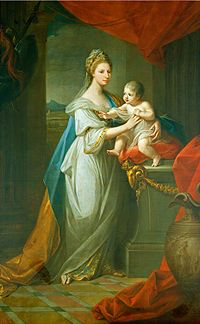
Augusta Frederica
Princess Augusta Frederica was a granddaughter of George II and only elder sibling of George III. She married into the ducal house of Brunswick, of which she was already a member. Her daughter Carolinewas the wife of George IV.
Princess Augusta Frederica was born at St. James’s Palace, London. Her father was Frederick, Prince of Wales, the eldest son of King George II and Queen Caroline of Ansbach and her mother was the Princess of Wales, Augusta of Saxe-Gotha.
Fifty days later, she was christened at St. James’s Palace by the Archbishop of Canterbury. Her godparents were her paternal grandfather, the King (represented by his Lord Chamberlain, the Duke of Grafton), and her grandmothers, Queen Caroline and the Dowager Duchess of Saxe-Gotha (both represented by proxies).
Her third birthday was celebrated by the first public performance of Rule, Britannia! at Cliveden in Buckinghamshire.
She was born second in the line of succession. Augusta was given a careful education and the negotiations about her marriage began in 1761.
On 16 January 1764, Augusta married Charles William Ferdinand, Duke of Brunswick-Wolfenb��ttel, at the Chapel Royal of St James’s Palace.
Augusta regarded the residence in Brunswick as too simple. She returned to Great Britain in 1764 in the company of Charles to give birth to her first child, and took a long time to return to Brunswick after the birth. During their visit in England, it was noted that the Brunswicks was cheered by the crowds when they showed themselves in public. This, reportedly, made them exposed to suspicion in the eyes of the court. During their visit, her sister-in-law queen Charlotte apparently refused them some honors at court, such as banning salutes to their honor. This attracted negative publicity toward the royal couple. During the negotiations thirty years later, when her daughter was to marry the Prince of Wales, Augusta commented the visit of 1764 to the British negotiator, Lord Malmesbury and stated her view that queen Charlotte disliked both her and her mother because of jealousy.
A new palace was built for her in Zuckerberg south of Brunswick to answer more to her taste, constructed by Carl Christoph Wilhelm Fleischer, and called Schloss Richmond, to remind her of England. When the palace was finished in 1768, Augusta moved there permanently.
The marriage was purely an arranged political marriage and Augusta and Charles regarded each other with mutual indifference. Augusta was indifferent to Charles’s affairs with Maria Antonia Branconi and Louise Hertefeld. Her indifference was sometimes seen as arrogance, and it gave rise to rumours and slander. Augusta’s popularity was severely damaged by the fact that her eldest sons were born with handicaps.
In 1772, Augusta visited England on the invitation of her mother. On this occasion, she was involved in a conflict with her sister-in-law queen Charlotte. She was not allowed to live at Carlton House or St.James Palace despite the fact that it was empty at the time, but was forced to live in a small house at Pall Mall. The queen had a conflict with her about etiquette, and refused her to see her brother the king alone. According to M. Walpole, the reason was jealousy from the part of the queen.
Augusta rarely appeared at the court of Braunschweig because of the dominance of her mother-in-law. When Charles became regent in 1773, her mother-in-law left the court and Augusta filled the position of first lady in the court ceremonies of Brunswick, although she often took short holidays to her personal palace Richmond. In 1780, Charles, already regent for his father, became sovereign duke, and Augusta became duchess consort.
The Swedish Princess Hedwig Elizabeth Charlotte described her, as well as her family, at the time of her visit in August, 1799:
Our cousin the Duke arrived immediately the next morning. He has won many victorys as a notable military man, are witty, litteral and a pleasant aquaitance but ceremonial beyond description. He is said to be quite strict, but a good father of the nation who attends to the needs of his people. After he left us, I visited the Dowager Duchess, the aunt of my consort. She is an agreable, highly educated and well respected lady, but now so old that she has almost lost her memory. From her I continued to the Duchess, sister to the King of England and a typical English woman. She looked very simple, like a vicar’s wife, has I am sure many admirable qualities and are very respectable, but completely lacks manners. She makes the stranges questions without considering how difficult and unpleasant they can be. Both the hereditary princess as well as princess Augusta – sister of the sovereign Duke – came to her while I was there. The former are delightful, mild, loveable, witty and clever, not a beauty but still very pretty. In addition, she is said to be admirably kind to her boring consort. The princess Augusta are full of wit and energy and very amusing. (….) The Duchess and the Princesses followed me to Richmond, the country villa of the Duchess a bit outside of the town. It was small and pretty with a beautiful little park, all after an English pattern. As she had the residence constructed herself, it amuses her to show it to others. (….)The sons of the Ducal couple are somewhat peculiar. The hereditary prince, chubby and fat, almost blind, strange and odd – if not to say an imbecill – attempts to imitate his father but only makes himself artificial and unpleasant. He talks contiunously, does not know what he says and is in all aspects unbearable. He is accommodating but a poor thing, loves his consort to the point of worship and is completely governed by her. The other son, Prince Georg, is the most ridiculous person imaginable, and so silly that he can never be left alone but is always accompanied by a courtier. The third son is also described as an original. I never saw him, as he served with his regiment. The fourth is the only normal one, but also torments his parents by his imoral behaviour.
In 1806, when Prussia declared war on France, the Duke of Brunswick, 71 at the time, was appointed commander-in-chief of the Prussian army. On 14 October of that year, at the Battle of Jena, Napoleon defeated the Prussian army, and, on the same day, at the battle of Auerstadt, the Duke of Brunswick was seriously wounded, dying a few days later. The Duchess of Brunswick, with two of her sons, and a widowed daughter-in-law, fled her ruined palace for Altona, where she was present with her daughter-in-law Marie of Baden at her dying husband’s side. Her other daughter-in-law, Louise of Orange-Nassau, left for Switzerland with her mother. Due to the advancing French army, Augusta and Marie were advised by the British ambassador to flee, and they left shortly before her husband’s death. They were invited to Sweden by Marie’s brother-in-law King Gustav IV Adolf of Sweden. Marie accepted the offer and left for Sweden, but Augusta left for Augustenborg, a small town east of Jutland. The Duchess of Brunswick remained here, with her niece, Princess Louise Augusta, daughter of her sister Queen Caroline Mathilde of Denmark, until her brother, George III finally relented, in September 1807, and allowed her to move to London. She moved to Montague House, Blackheath, in Greenwich, with her daughter, the Princess of Wales, but soon fell out with her daughter, and purchased the house next door, Brunswick House, as she renamed it. The Duchess of Brunswick lived out her days in Blackheath and died, in 1813, aged 75.

Space Opera Books Presents A Trolling We Will Go Omnibus:The Latter Years
A Trolling We Will Go Omnibus:The Latter Years
Not only do I write Regency and Romance, but I also have delved into Fantasy.
The Trolling series, is the story of a man, Humphrey. We meet him as he has left youth and become a man with a man���s responsibilities. He is a woodcutter for a small village. It is a living, but it is not necessarily a great living. It does give him strength, muscles.
We follow him in a series of stories that encompass the stages of life. We see him when he starts his family, when he has older sons and the father son dynamic is tested.
We see him when his children begin to marry and have children, and at the end of his life when those he has loved, and those who were his friends proceed him over the threshold into death.
All this while he serves a kingdom troubled by monsters. Troubles that he and his friends will learn to deal with and rectify.
Here are the last two books together as one longer novel.
Trolling, Trolling, Trolling Fly Hides! and We���ll All Go a Trolling.
Available in a variety of formats.
For $5.99 you can get this fantasy adventure.
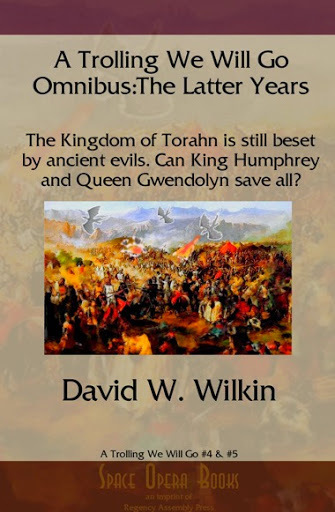
Barnes and Noble for your Nook
The stories of Humphrey and Gwendolyn. Published separately in: Trolling, Trolling, Trolling Fly Hides! and We’ll All Go a Trolling. These are the tales of how a simple Woodcutter who became a king and an overly educated girl who became his queen helped save the kingdom of Torahn from an ancient evil. Now with the aid of their children and their grandchildren.
Long forgotten is the way to fight the Trolls. Beasts that breed faster than rabbits it seems, and when they decide to migrate to the lands of humans, their seeming invulnerability spell doom for all in the kingdom of Torahn. Not only Torahn but all the human kingdoms that border the great mountains that divide the continent.
The Kingdom of Torahn has settled down to peace, but the many years of war to acheive that peace has seen to changes in the nearby Teantellen Mountains. Always when you think the Trolls have also sought peace, you are fooled for now, forced by Dragons at the highest peaks, the Trolls are marching again.
Now Humphrey is old, too old to lead and must pass these cares to his sons. Will they be as able as he always has been. He can advise, but he does not have the strength he used to have. Nor does Gwendolyn back in the Capital. Here are tales of how leaders we know and are familiar with must learn to trust the next generation to come.
Feedback
If you have any commentary, thoughts, ideas about the book (especially if you buy it, read it and like it ;-) then we would love to hear from you.

March 14, 2015
Regency Personalities Series-Thomas Thynne 1st Marquess of Bath
Regency Personalities Series
In my attempts to provide us with the details of the Regency, today I continue with one of the��many period notables.
Thomas Thynne 1st Marquess of Bath
13 September 1734 ��� 19 November 1796
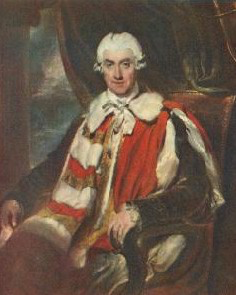
Thomas Thynne
Thomas Thynne 1st Marquess of Bath was the elder son of Thomas Thynne, 2nd Viscount Weymouth (1710���1751), and the great-grandnephew of Thomas Thynne (c. 1640���1714), who was created Baron Thynne and Viscount Weymouth in 1682.
His mother was Louisa (d. 1736), daughter of John Carteret, 1st Earl Granville, and a descendant of the family of Granville who held the earldom of Bath from 1661 to 1711. The Thynnes are descended from Sir John Thynne, the builder of Longleat, the splendid seat of the family in Wiltshire. Sir John owed his wealth and position to the favour of his master, the protector Somerset; he was comptroller of the household of the Lady Elizabeth, and was a person of some importance after that princess became queen. Another famous member of this family was Thomas Thynne (1648���1682), called on account of his wealth “Tom of Ten Thousand.” He is celebrated by Dryden as Issachar in Absalom and Achitophel, and was murdered in London by some Swedes in February 1682.
Born on 13 September 1734, Thomas Thynne succeeded his father as 3rd Viscount Weymouth in January 1751 and was Lord Lieutenant of Ireland for a short time during 1765, although he never visited that country. Having, however, become prominent in British politics, he was appointed Secretary of State for the Northern Department in January 1768; he acted with great promptitude during the unrest caused by John Wilkes and the Middlesex election of 1768. He was then attacked and libeled by Wilkes, who was consequently expelled from the House of Commons.
Before the close of 1768 he was transferred from the northern to the southern department, but he resigned in December 1770 in the midst of the dispute with Spain over the possession of the Falkland Islands.
In November 1775 Weymouth returned to his former office of secretary for the southern department, undertaking in addition the duties attached to the northern department for a few months in 1779, but he resigned both positions in the autumn of that year.
In 1789 he was created Marquess of Bath. He died in November 1796. Weymouth was a man of considerable ability, especially as a speaker. According to more modern standards, his habits were very coarse, resembling those of his friend and frequent companion Charles James Fox. Horace Walpole refers frequently to his idleness and his drunkenness, and in early life at least “his great fortune he had damaged: by such profuse play, that his house was often full of bailiffs.” He married Elizabeth (died 1825), daughter of William Bentinck, 2nd Duke of Portland, by whom he had three sons and three daughters.
He was High Steward of the Royal Town of Sutton Coldfield from 1781 until his death.


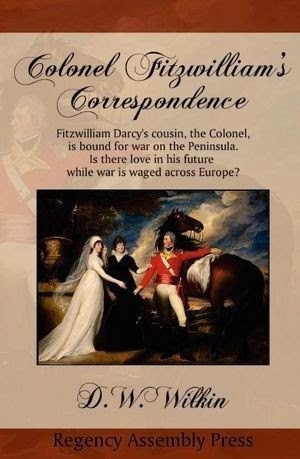


 Tales by the Tree
Tales by the Tree

